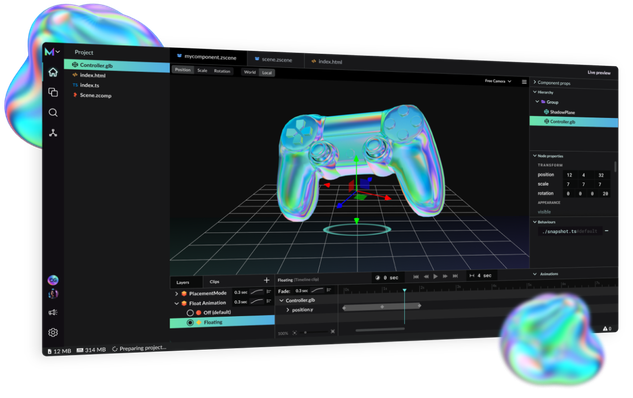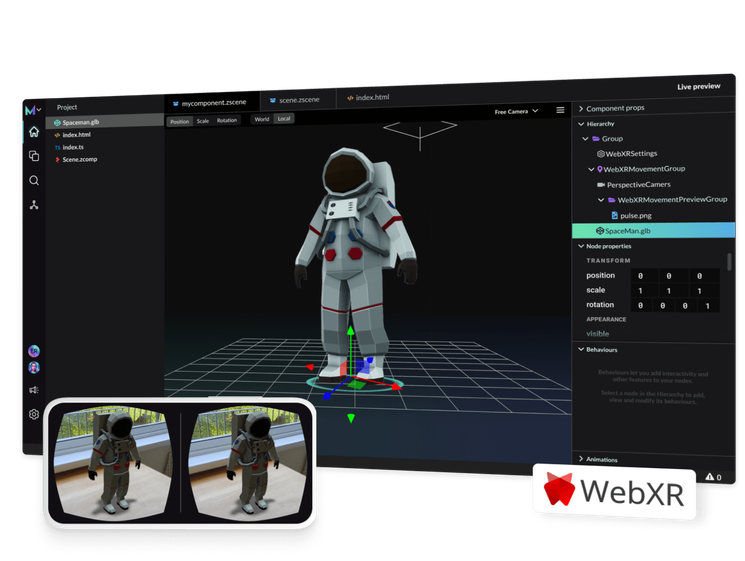What is WebXR?
WebXR is a technology standard / API designed to make Augmented, Virtual and Mixed Reality (AR, VR and MR) experiences accessible through the web (also known as XR). Content built with WebXR can be accessed on a range of headsets and devices, typically without any modification. Headsets that support WebXR include: the Apple Vision Pro, Meta Quest, Magic Leap and Zapbox. Generally, these headsets support both Virtual and Augmented reality WebXR content out of the box, enabling both full virtual worlds and passthrough experiences. For handheld, WebXR’s ‘immersive AR’ mode is supported by Google Chrome, enabling high quality ‘world tracked’ 3D content on supported devices.

Build WebXR experiences with Mattercraft
Mattercraft is the ultimate web development tool for WebXR. With comprehensive controller support, XR cameras, locomotion and advanced hand tracking capabilities while leveraging the best 3D web rendering engine (three.js), Mattercraft stands as the unrivalled choice for WebXR development.
All the power of the web
The WebXR framework / API expands VR and AR's reach by eliminating the need for extra apps or plugins and providing a platform for easily shareable experiences accessible from anywhere with an internet connection.
Low Friction
WebXR experiences are accessible directly in a web browser without additional software. This means users can access and enjoy WebXR content without specialized hardware or software.
Cross-Platform Compatibility
WebXR experiences work on many devices, such as phones and VR headsets. Developers can make experiences that work on all platforms, without making different versions for each platform.
Easy to Build
WebXR is based on familiar web technologies like HTML, CSS, and JavaScript, making it easy for developers to create immersive experiences without specialized skills or knowledge.
Vibrant Developer Ecosystem
Since WebXR experiences are just front-end web pages, existing tooling and libraries for web development, including the NPM package library, can be leveraged by developers.
High Performance
WebXR can fully utilize a user's device, including the GPU and other hardware, to create immersive and fast experiences. This means that WebXR content can be just as powerful as native VR and AR apps, while still being accessible through a web browser.
Supported browsers and headsets
Google
Chrome
(For AR)

Meta Quest Web
Browser
(For AR and VR)
Apple Vision
Pro
(For VR)
Zapbox
(For AR and VR)
MagicLeap
(For AR and VR)
WebXR Examples
Start building WebXR experiences using our easy-to-use templates in Mattercraft.
Controller support
Use controller tracking, controller inputs and raycast events to build immersive XR content deployed directly to the web.
Hand Tracking
Track hands, listen for gestures or use your hands as controllers to enable user input, perfect for headsets like the Apple Vision Pro.
Locomotion Systems
In full Virtual Reality experiences, use the locomotion systems to move around your 3D scene. Make use of teleport, walk or turn movement controls.
What is the difference between WebXR and VR?
What is WebXR?
WebXR is an emerging technology standard designed to make Augmented, Virtual and Mixed Reality (AR, VR and MR) experiences accessible through the web (also known as XR). This API enables developers to create immersive experiences directly within web browsers, eliminating the need for standalone applications. WebXR bridges the gap between standard day-to-day user devices and rich, interactive 3D environments, offering a platform-agnostic approach to immersive web content. Whether you're exploring virtual worlds, viewing 3D models, or interacting with augmented reality overlays, WebXR is at the forefront of bringing these experiences to a broad audience through the convenience of the web.
Which browsers are compatible with WebXR?
Compatibility with WebXR is rapidly expanding among major web browsers to support immersive experiences directly from the internet. As of now, browsers that offer WebXR support include Google Chrome, Mozilla Firefox, Microsoft Edge, and Apple's Safari on iOS. These browsers have integrated WebXR APIs to enable XR content to run seamlessly on various devices, including desktops, smartphones, and dedicated VR headsets (such as the Meta Quest, Apple Vision Pro, Zapbox and Magic Leap).
What is the difference between WebXR and VR?
WebXR is a technology framework that encompasses 3D handheld and headset web content under a single API, enabling developers to create immersive experiences that can run on a wide range of devices. The key difference between WebXR and traditional VR is in its delivery platform. Like WebAR, WebXR brings these experiences directly to web browsers, offering a more accessible and versatile way to engage with immersive Mixed Reality content. This means users can access Virtual Reality and Mixed Reality content without the need for specialized apps, making it a game-changer in how we interact with digital environments.
What can I use WebXR for?
WebXR opens up a world of possibilities for creating and experiencing immersive web content. It can be used for a wide range of applications, including virtual tours, product visualizations, employee onboarding, educational simulations, gaming, interactive training, and virtual showrooms. WebXR also offers unique opportunities for creative expression and storytelling, allowing artists and designers to build engaging, spatial experiences that users can explore. WebXR is transforming how we interact with the web, providing powerful tools to create engaging, interactive experiences that were previously unimaginable.
